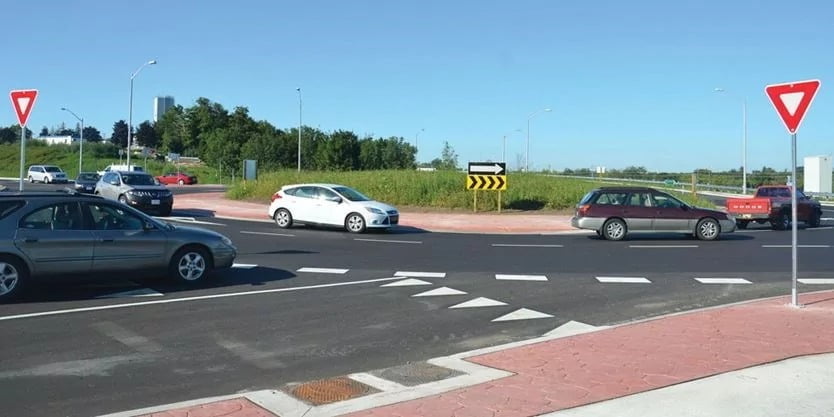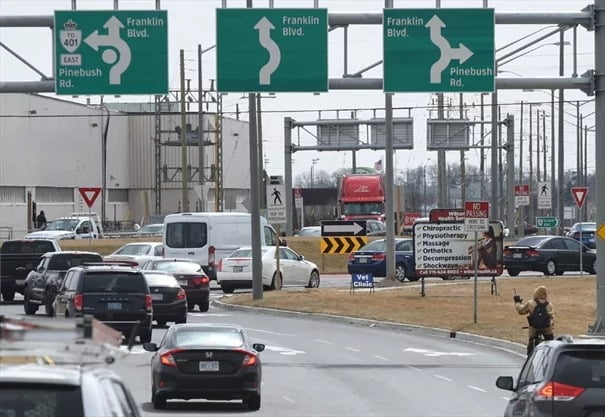Waterloo Region road planners have fallen in love with roundabouts! In recent years, roundabouts have gone from being a curiosity you might encounter in some quaint, sleepy neighbourhood 20 minutes out of the way to a regular feature of many main thoroughfares and highly trafficked areas. In cities like Kitchener, Waterloo and Cambridge, there are literally dozens of roundabouts, practically guaranteeing that any trip you take through the area will see you navigating at least a few of the curvy, and sometimes confusing, intersections.
But, while roundabouts have become a staple of southern Ontario, drivers still don’t seem entirely comfortable with the idea. Roundabouts supposedly convey two major advantages over traditional 4-way stop and light controlled intersections. Namely, they are supposed to speed the flow of traffic in an area with a smoother and easier path through the intersection, and secondly, they are supposed to increase motorist safety. But have they really done that?
A 2017 University of Waterloo study provides some useful answers to this question. The study finds that while roundabouts see an overall reduction in severe accidents (accidents where serious injury or damage occurs) when compared to normal intersections, the total number of incidental accidents actually increases. To put it plainly, roundabouts are great for reducing the chance of life-threatening accidents like a T-bones or head-on collisions, but they tend to increase the chances of you getting in a fender bender.
Overall, we can take this as an endorsement of these intersection alternatives. Anything that lowers the chances of death and serious injury on the road is a good thing. But, what’s up with all the fender benders? Why are you statistically more likely to scrape bumpers with another car, or knock out a taillight on these supposedly safer junctions?
The truth is, many people still don’t fully understand how to behave and navigate through a roundabout but are afraid to admit it. While new drivers are taught how to use roundabouts as part of their driving school, many veteran motorists who have been licensed for years are encountering them as a new challenge. That’s why we think it’s important to brush up the rules!
Entering a roundabout
The first thing to remember when you come across a roundabout is to stay calm. You don’t want nerves leading you to a bad decision (or an embarrassing YouTube clip). Slow down, look for the lane signs, and pick the right one for your destination.
Remember the golden rule – drivers in the roundabout have right-of-way. They are not expected to stop, make room, or otherwise “let you in.” When entering a roundabout, you need to wait your turn for a clear entry point. Also, be sure to stay aware of any pedestrians, they also have right-of-way.
PROTIP: Don’t do this » Driver Caught on Camera Driving Wrong Way in Roundabout (CTV Kitchener)
Picking your lane
Which lane you choose will depend on which exit you want to take. If you’re exiting right, pick the right-most lane and travel on the outer lane. Going straight through? You can choose either lane, but typically, the right most is the easiest and will lower your chances of collision if another motorist ignores the rules. Finally, if you’re taking the third exit, choose the left-most lane travelling through the inner lane and exiting from the inner lane. You should never change lanes in a roundabout.
Remember to signal
A roundabout is still an intersection and you should always signal your intention as you enter. Just like a typical intersection, signal right if you are exiting right, signal left if you are exiting left, and not at all if you are going straight.

In the roundabout
Once you find your opening, join the flow of traffic in the roundabout. The key word here is “join.” Keep pace with the vehicles already in the roundabout, never try to pass another vehicle, and don’t go so slowly that you force other motorists to pass or go around you.
If an emergency vehicle approaches with its lights on, do not stop. Clear the roundabout as normal and then pull over to the right and allow the emergency vehicle to pass you after you exit.
Always stay aware of other drivers while in the roundabout and watch for anyone drifting into your lane. This is the same as on double turning lanes – if everyone follows the rules properly there should never be a problem, but we also know we can’t count on that. Be responsible for your own safety and keep an eye on what your fellow motorists are doing.
Large vehicles
If you are driving a particularly large and cumbersome vehicle that runs a high risk of accidentally overstepping your lane, enter the roundabout by straddling the two lanes. Yes, this feels very odd, but it is the proper behaviour for a large vehicle. Remove the threat of incidental contact with another vehicle by simply taking up both lanes.
Obviously, drivers or normal sized vehicles should be aware of this too. Don’t try to pass or otherwise force yourself into an occupied lane taken up by a large vehicle, and don’t honk either. Take it easy, give space, and look out for your own positioning.
Keep these rules in mind when encountering a roundabout and you shouldn’t have any difficulty.
More information on roundabouts can be found on the Region of Waterloo website.





0 Comments